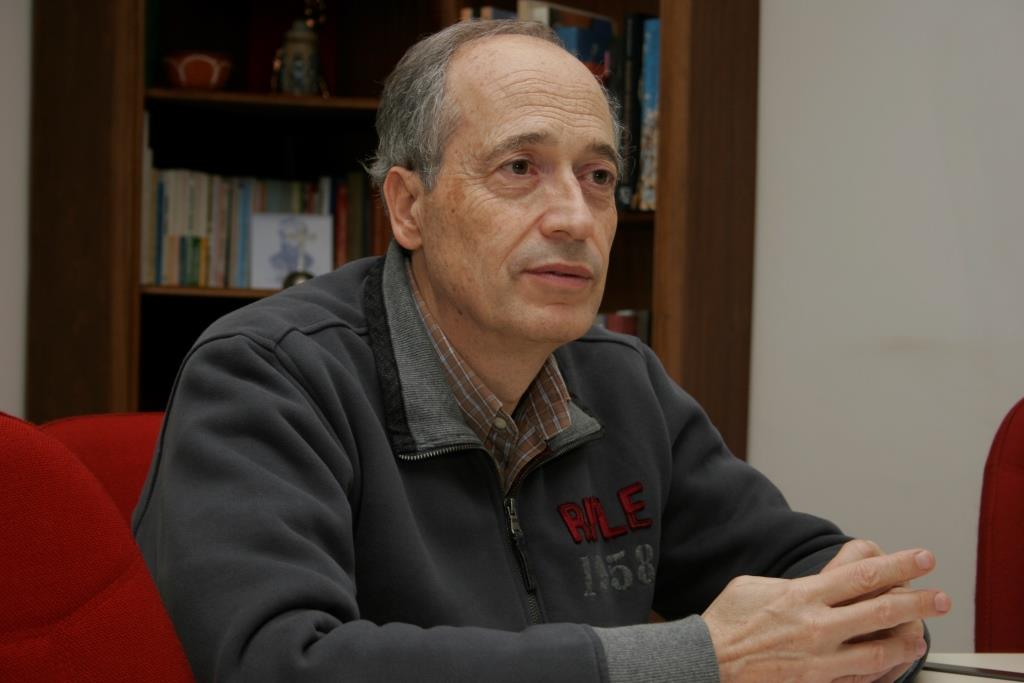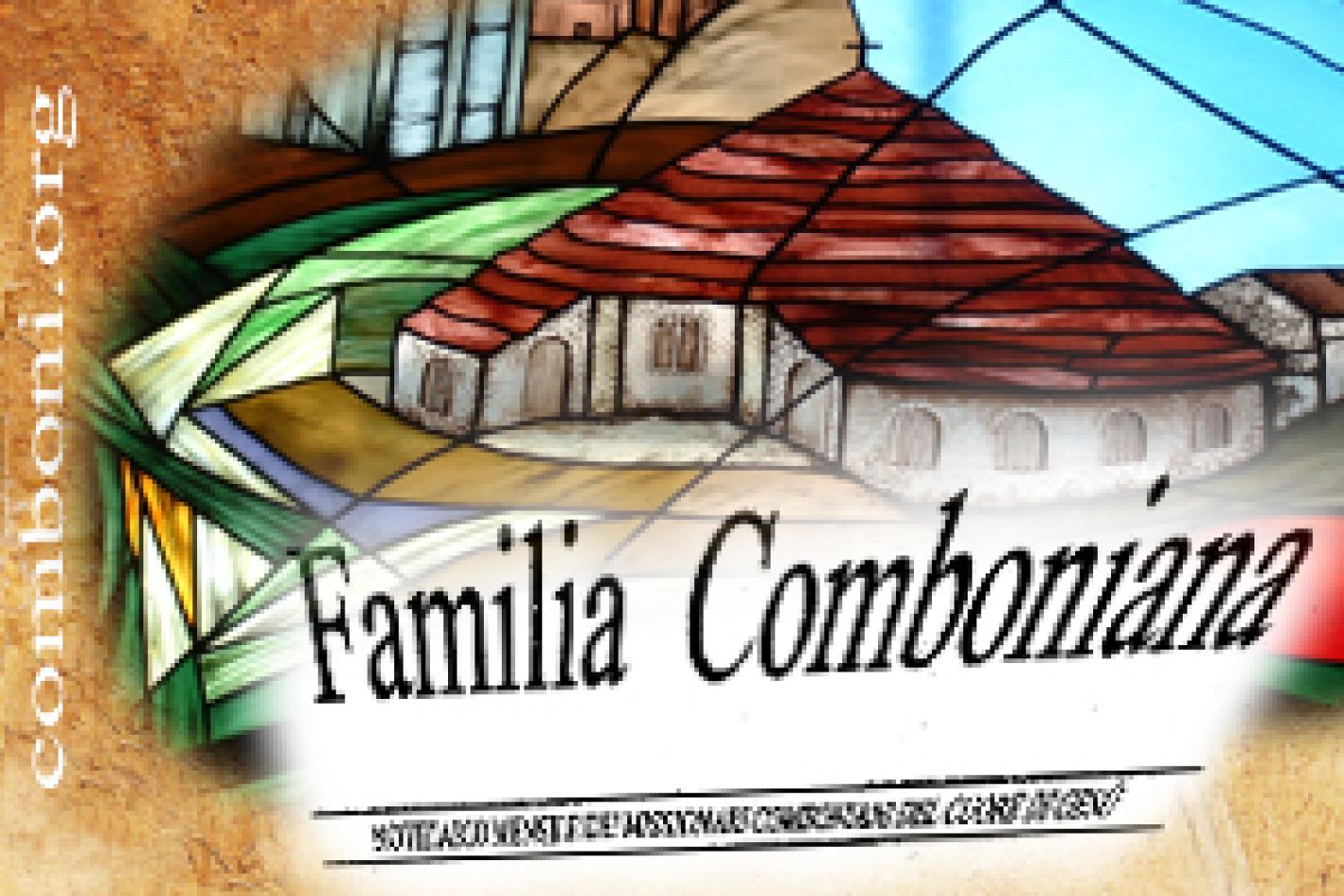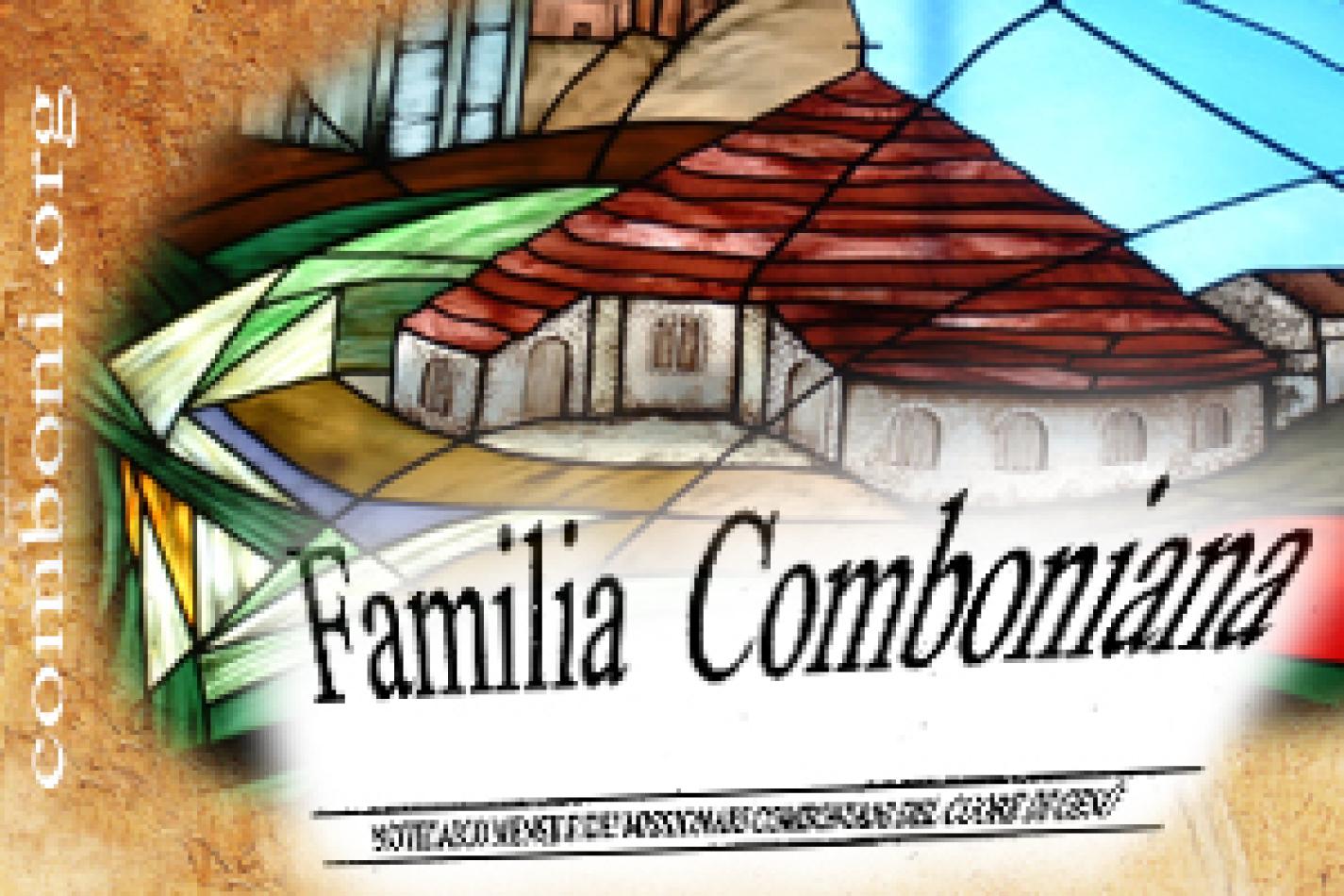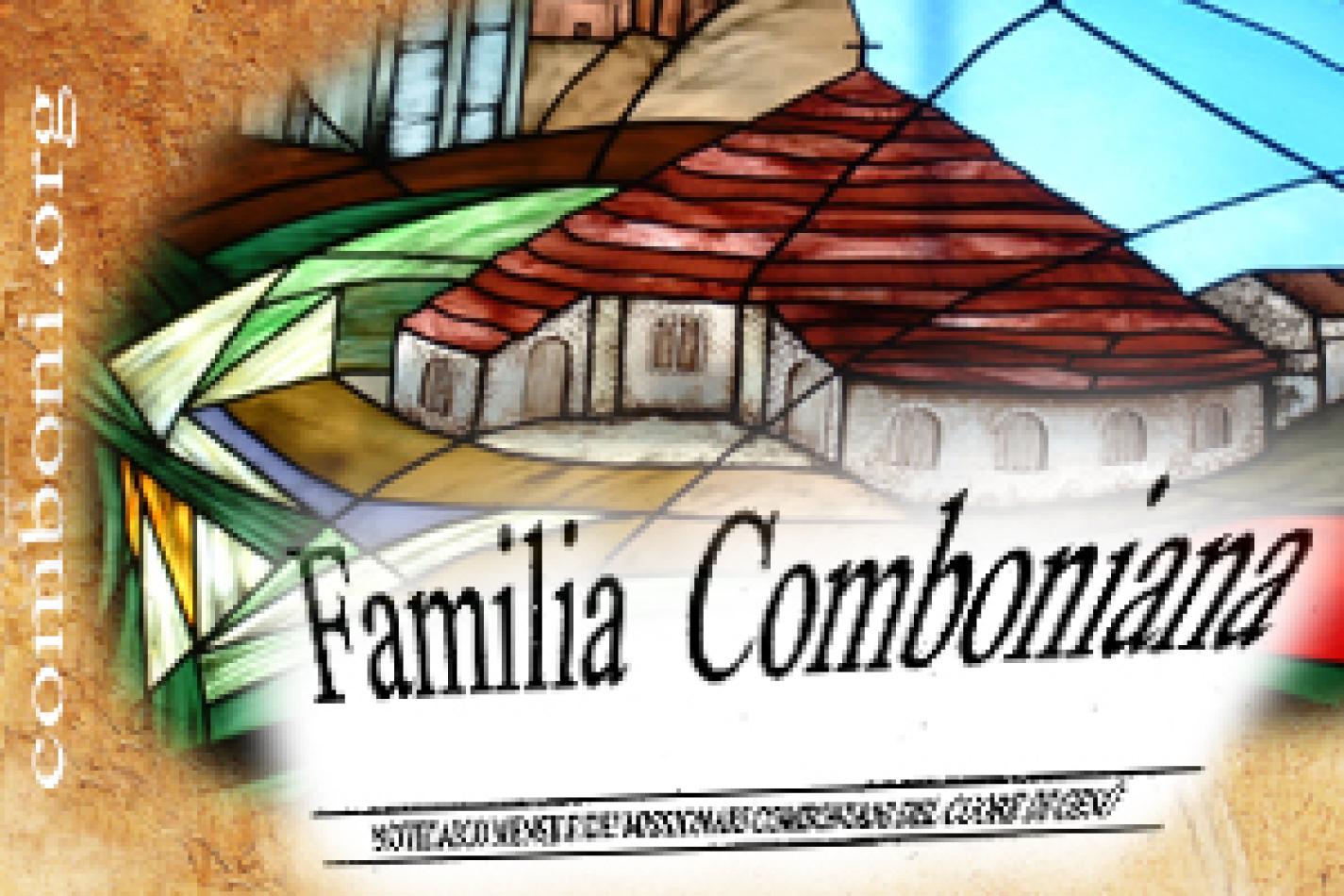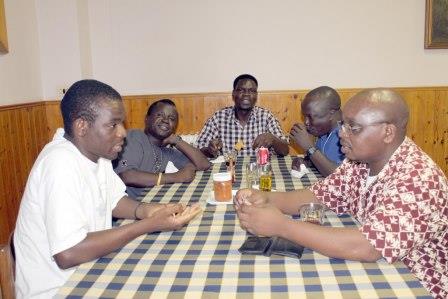Daniel Comboni
Comboni Missionaries
Institutional area
Other links
Newsletter
Thursday, August 29, 2013
“The icon of the Comboni missionary is less and less the image of St. Paul and more and more the image of John the Baptist, the one who withdraws. He has fewer roles as a decision-maker and more positions of hidden service, less that of the master and more that of the servant, if we are to use evangelical imagery. Not only have the roles changed but also the understanding itself of the mission and those who claim it as their right: the local Church.” Fr. Alberto Pelucchi, Vicar General.
“Even though confreres from Europe are still, slightly, in the majority, vocational geography and the ageing of many confreres in the North make it clear that the Institute is living through a rapid transition from the North to the South of the world.”
In the picture in Rome:
Sc. Ndhlovu Justin,
Fr. Aleti Apalolem Z. Chris,
Fr. Adaku Isaac Augustine,
Fr. Charles, diocesan priest of Uganda,
Fr. Mbuthia Simon Mwaura.
“PATHS OF RECONCILITION IN OUR HISTORY AS AN INSTITUTE”
1. A ‘wounded’ Institute
The previously published article by Fr. Siro Stocchetti opened by reminding us that we are all wounded in some way, but not all in the same way or to the same degree... and of how we learn to live with these wounds in different ways... how the depth and the perception we have of these wounds may be varied, and how the same applies to how aware we are of them and how they condition us.
While wishing to avoid a reflection that may be over intimist or introverted, we all allow ourselves to be guided by the awareness that what remains hidden and ignored – that which does not come to light – cannot be acknowledged and so lead to pardon and reconciliation; it does, however, continue to condition us and exercise its destructive power and its ability to create divisions among us.
These are conditionings and divisions that make themselves felt in our personal histories as well as in the wounds that we have experienced in our history and choices as an Institute, lived and interpreted by people whose origins, sensitivities and cultures are extremely varied.
From this viewpoint it is possible to speak also of a wounded Institute, whose wounds are not simply the sum of the various wounds of the individual members.
Perhaps, aware that wounds, if left untreated, may become permanent sores, the last General Chapter says that it is time now to identify and heal the wounds present in our midst (143.3).
It is to this process requiring courage and conversion of the heart by all of us (cf. AC 2009, 53) that we wish to turn our attention in this fourth contribution to the theme of fraternity.
2. Weighty words (and the example of the ostrich)
Words such as racism, intolerance, discrimination, prejudice, ethnic conflict, nationalism and sexism are words that seem particularly weighty and embarrassing in the context of the religious life. Simply hearing them conveys a feeling of defeat: they are words that evoke a betrayal of the values we hold so dear and that we feel we must proclaim to others.
I remember how some of these words made headlines in the work of the 2003 Chapter, even though they were soon silenced amidst feelings of embarrassment.
The last Chapter had none of these qualms when it explicitly asked that the commissions of OGF offer the tools needed to help identify and heal the wounds present in our midst, often caused by prejudice and discrimination and should animate the Circumscriptions to organise seminars or to utilise other already existing programmes for the resolution of conflicts (143.3).
We must not be surprised if – when we speak of wounds of this sort – the most instinctive and immediate reaction is to deny, remove or rationalise: typical defence mechanisms that lead us to bury our heads in the sand, as the classical example of the ostrich teaches us.
Or, more intelligently, they bring us to invent elaborate excuses or a series of “I distinguish” which, finally, do not allow us to tell truth from falsehood, light from shadow. Again, still more simply, they force us to abandon the problem with a witty remark or by saying “anyway, there is nothing we can do about it”. Providence desires not that we should live like ostriches or people who have given up, but that we should live as a visible sign of the new humanity born of the Spirit (RL 36), the people of God whom He called out of darkness into his own wonderful light (1Pt 2.9).
3. BEING RECONCILED - some historical facts and events of the Institute
- “The truth will set you free”
How often have these words of Jesus opened our hearts and made us dream! The truth which sets us free is not only He and the truths we find in Him but also includes those painful truths about ourselves that will set us free in so far as we free ourselves of them: the hidden and unhealed wounds are still hurting us, slowing us down – like baggage that we carry and becomes heavier as we go along – and poison the air around us.
We may free ourselves of them and neutralise their negative effects, first of all by acknowledging their existence, recognising them for what they are and calling them by their real names. In this interpretation of faith and hope, we are accompanied by the One who makes all things new and in whom all the wounds and sores may be healed; it is in His promise that we find the motives and the spirit to face certain truths regarding the Institute that have often been silenced or glossed over.
The selection that follows presents examples of “negative experiences of divisions, conflicts, rash judgements, episodes of intolerance and mental and cultural closure” and of changes suffered that our Institute has lived through and continues to live through (see introductory letter of the GC); it does not pretend to be either exhaustive or complete and cannot but reflect the sensibility and perception of the author. However, it does aspire to being a small contribution to a process of liberation and growth.
- “Religious” or (solely) missionaries; both together or, perhaps…?
This has been one of the most frequently recurring themes of debate that I can remember since I entered the Institute. Equally numerous are the reasons presented pro and contra either one or the other proposal. At first, the wishes of the Founder were appealed to, only to be reviewed and corrected in the light of new letters and testimonies. “Take the mission as the starting point”, it is often said. “Yes, but the Rule of Life starts from religious life and only then speaks of the mission”, others note. What mission do we speak of? The mission lived individualistically or as a community where everything is shared? “Everything, yes, but allow me to say that we do not mean all the money”, others specify. “Beware of the monkish spirit against which Comboni warned his followers”, others add. And so on.
I cannot say for certain whether we have achieved a true synthesis or have just set the question aside, on stand-by. This conflict has produced good fruits and reminders but, I suspect, has also provided excuses for the weakness and fragilities which had and have more to do with human nature than the desire for greater fidelity to the requirements and demands of the mission and religious life.
- Dividing into two Institutes and other divisions
Ninety years have passed since that sorrowful day; much progress and many gestures of reconciliation have been made since then, apart from the formal day of reunification. Obviously, many among us have never known or felt the effects of that division, now in the distant past.
It must be said, however, that mention is made here of the affair more for the sake of historical exactness than anything of importance now: it was an embarrassing event which, thanks be to God, is now mercifully lost in the mists of time. It is now, not just gone and forgotten, but also, it is to be hoped, forgiven.
However, there are now other signs of internal divisions giving cause for concern; for example, the division – also among ourselves – between those who have/receive abundant financial help and those who do not; the cultural and social divisions between North and South that are felt also within our Institute; the evident difficulty in considering and accepting to ‘reunite’ our circumscriptions, caused, at least in some cases, by the re-emergence of the spirit of regionalism and nationalism among ourselves, accentuated by memories of painful rapports, sometimes the consequence of colonial history; the use of terms of violence and, lastly, the re-emergence of strongly exclusive and excluding prejudices that speak of cultural and ethnic barriers rather than friendship and brotherly solidarity (cf. RL 18).
The scene seems to point the finger at truths that have escaped us or to which we have been unable to give sufficient importance or attention. One is not born capable of ‘internationality’, one becomes so. This is a truth of which the Rule of Life reminds us (cf. 18.1).
- Choice of Latin America as a new mission field for the Comboni mission
The decision to go to Latin America, even if it is always said that it was at the invitation of the Holy Father, was not without its pains. It is true that also this memory, like in the previous case, is beginning to become part of the distant past but I cannot fail to remember judgements and unfair comparisons regarding ‘the mission’ and its fields of work; there have been interpretations of the charism, sometimes contemptuous and intolerant by one party towards the other and vice versa, even in recent times.
The passion for one’s own mission – which sometimes motivated such reactions – certainly cannot justify or remove the unease and suffering that resulted from them. Such reactions reappeared and made themselves felt following the decision to open in Asia.
The process or requalification and reduction of commitments (also in Africa), the ageing of part of the Institute, the drop in vocations in Europe and the increase in confreres from the South of the world have helped to blur the terms of the question.
One might think that, by now, we should have overcome and integrated this in a new vision – no longer merely geographic – of the mission and its boundaries; it was new only up to a point, seeing that the 1969 Chapter had already interpreted the charism from a mission standpoint, freed from strictly geographic boundaries (the choice of Latin America was, in fact, given as an example).
Doubtless, this has made us more aware how it is possible to harm ourselves even in the name of the mission that we all have at heart, the reason for our existence and identity.
- We ourselves and the feminine (branch)
On 17 March, 2002, the Comboni Institutes issued a letter entitled “Collaborating in Mission”. It began by affirming that our Founder viewed missionary commitment as the fruit of collaboration among all the ecclesial resources, both men and women without distinction. Together, these made up a cenacle of apostles, men and women of various nations and cultures (cf. 4).
The letter presented the history and positive collaboration experienced in both the past and the present, proceeding from an informal level to one that was more official and institutional, encouraging their continuation and proposing a return to some fundamentals. It ended by proposing and re-proposing pathways that were still open and possible for individuals, communities and Institutes, aware that we must recognise and accept that we need each other, with our resources and vulnerabilities (36).
Similarly, it also pointed out the limits, conflicts and resistance experienced during such a process of collaboration and communion among the Institutes, beginning with the man-woman relationship itself. In this regard it cited the lacunae of a poor human formation regarding relations with the ‘female’ gender (or even with one’s own), subtle forms of prejudice and the lack of authenticity that stand in the way of responsible and fraternal relations, an inadequate knowledge of the respective vocations and clericalism that is still present and operative in the vision and understanding of the mission, of roles and ministries, the result of a deficient ecclesiological vision (see 13-16).
The 10th anniversary of that letter has already passed and, as we have started to do with other anniversaries, we ought to celebrate it properly. We might start with a request/prayer for pardon on our part, both as children of a human society that has often oppressed and continues to oppress, exploit and discriminate against women, and as members of a Church whose language, theology, institutions and expressions are always markedly masculine (it is not easy to question this).
- We ourselves and the priest/brother relationship
That same clericalism and other causes listed above have been among the main causes of suffering, a sense of discrimination and the denial of human rights (not just religious rights), regarding the non-clerical component of the Institute. I cannot but recall the suffering and bitterness openly shown or detectable in the accounts and memories of not a few Comboni Brothers of the ‘old school’, and that are still felt today.
It is obvious that it is not always a question of clericalism but also of causes related to personal character, of being the victims of human history and deficiencies and not just the authors.
These are pages of our history that make us think and bow our heads. Pages that still have to find peace.
- Epochal changes: from North to South...
Right from the opening pages, the Acts of the last Chapter refer to these changes: The Comboni Institute is living through a phase of deep and rapid transformation. While enriched by new nationalities and cultures, we also face negative developments, resistance to the “old” or the “new” and challenging situations. (AC 2009, 3.4). A reflection echoed by these lines: The Institute is growing fast in internationality and interculturality, is experiencing radical generation, social and cultural change. This phenomenon inevitably provokes tensions and a sense of unease (53).
Even though confreres from Europe are still, slightly, in the majority, vocational geography and the ageing of many confreres in the North make it clear that the Institute is living through a rapid transition from the North to the South of the world.
It is a transition that signifies handing things over at all levels, including institutional posts and services, involving also the need to acquire new languages and cultural expressions. It is an obligatory movement that brings to light, on the one hand, the difficulty of “letting go”, of handing over to others (somewhat like the difficulty parents experience when they have to hand over to their children firstly that which is their due and then even tasks which the parents felt belonged to them).
This passing on is sometimes marked by sentiments of suspicion, a lack of confidence, judgements and comments that are harsh and not very understanding, sometimes clearly racist. And, on the other part, a constantly growing feeling of frustration and impatient waiting that sometimes gives way to sentiments that are not very fraternal.
It is undeniable that a good proportion of confreres, almost all from the North of the world, today more than in the past, are required to enter into a dynamic of death. Not only do they find they are ‘mourning’, faced with an Institute profoundly different from the one they knew and which they entered fifty years ago, but they are also called to mourn their roles, their responsibilities and their way of living and expressing them. A bit of extra help as to how to carry out the mourning would not do any harm.
- … from protagonists in mission to collaborators …
As if this were not enough, internally, the roles in missionary work have been inverted. They are no longer the protagonists, no longer “a voice” or the only voice of others who have, by now, acquired sufficient voice and experience. The icon of the Comboni missionary is less and less the image of St. Paul and more and more the image of John the Baptist, the one who withdraws. He has fewer roles as a decision-maker and more positions of hidden service, less that of the master and more that of the servant, if we are to use evangelical imagery.
Not only have the roles changed but also the understanding itself of the mission and those who claim it as their right: the local Church.
In addition to this, our times increasingly show that the vision and sensibilities of mission of confreres who come from the (so-called) mission lands are not the same as those of confreres who come from the old North.
It is not easy to come to terms with all of this. We are called to be reconciled not only with the shadows and wounds of the past, but also to be reconciled with the present (and the future) time that upsets us and, at times, generates doubts and regrets.
Paradoxically, the present is largely the fruit of choices made in the past, it is the present spoken of in the past as the future to be built up and to be aimed at, and for which one worked with a spirit of sacrifice at great cost.
Despite this, the present finds among us confreres who are not prepared to welcome it. They are embittered, at times, by the modalities it has assumed and by the unforeseen consequences it has brought about.
- Being witnesses of the One who came to offer us a life that is full, human and holy
This contribution is coming to its conclusion. But the journey is not ended. We have revisited some events, recognising their existence and their truth and we have called them by their proper names: every salvific experience can only start from here. This is the first step.
The next step consists in reconciling ourselves with the truth that these events have told us about ourselves and about myself; let us do this without fear, accepting the responsibility that falls to us in them, with a great sense of freedom and trust: we know that God loves us and takes up, together with us, our history, opening it up to a future of grace and liberation.
The third step is, therefore, to open ourselves to forgiveness and public gestures of reconciliation, asked expressly of those we have wounded and given in our turn. The final contribution to this year dedicated to Fraternity and Paths of Reconciliation ought to assist us in this.
The fourth step is part of a continual journey of conversion which has its own stages and definite requirements: we may learn from our mistakes and errors and live more wary of them, starting with listening and reciprocal dialogue.
I have in mind, for example, all the inspiration given to us by stories of non-violent movements and the instruments they have developed for the resolution of conflict and the dynamics of reconciliation. They, too, are part of the today of God for us, signs of grace and new life.
30 July 2013
Fr. Alberto Pelucchi
Vicar General

